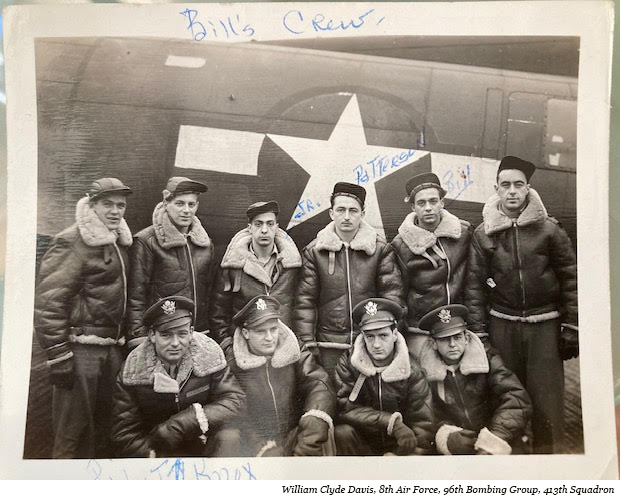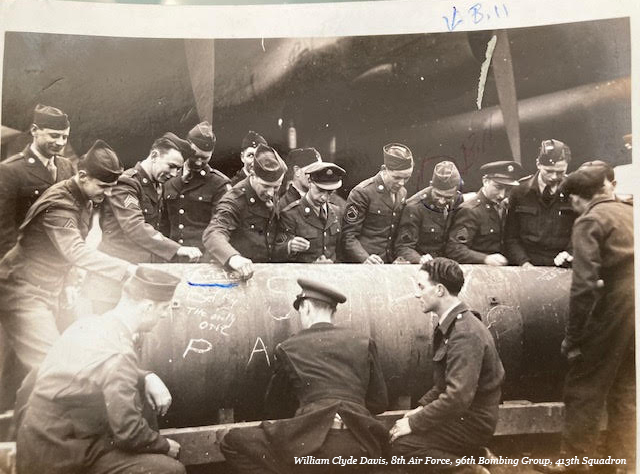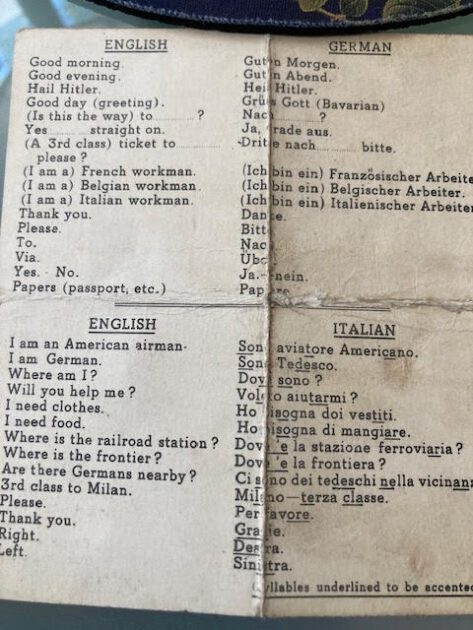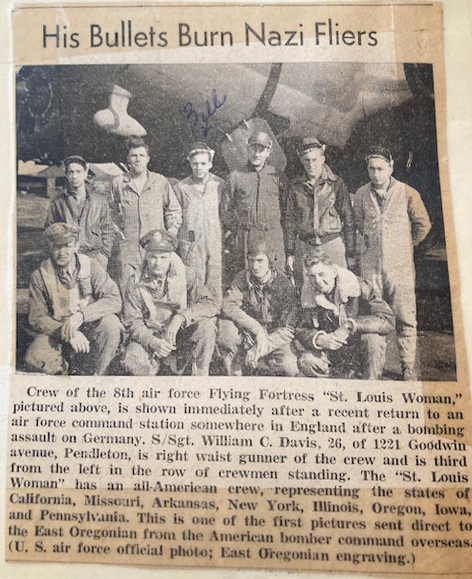Out of the Attic: Snapshot of a Flying Fortress Waist Gunner

by Sharon Bowles
It doesn’t look like much. It’s just your basic faded green fabric scrapbook from the dime store; but oh, the treasures that lie within! For this is the scrapbook my newlywed aunt Arista Houston Davis created in 1943-1944, while her young husband Bill Davis was serving on a US B-17 bomber crew far away in eastern England.

I had already inherited a big box of letters Bill wrote to his wife while in the Army Air Force, as well as a copy of his singed-edged military records. I had to make some strong promises to my brother to let me take this scrapbook home for further investigation. I hoped to be able to flesh out some of the stories that Bill referred to in his letters, and so much wanted to get some pictures to go with them. I was not disappointed!
William Clyde Davis was a 24-year-old mill worker from Pendleton, OR when he entered what later became known as the USAF at Portland, OR on May 19, 1942. He was stationed at Dallas, TX, where he completed the official Airplane Mechanics course at the Dallas Aviation School at Love Field. While there, he met a curvy brunette who worked in a defense factory located next door. In April of 1943 the couple tied the knot and became my beloved Aunt “Sister” and Uncle Bill. The full story of their wartime courtship and early, long distance marriage has many chapters, which I will save for a future installment of Out of the Attic.
Bill shipped out in the fall of 1943 with the 8th Air Force, 96th Bombing Group, 413th Squadron, located at Snetterton Heath, UK. This is near the city of Norwich.* He flew on 27 missions from his base in England between Sept. 26, 1943 and May 31, 1944. He was an engineer (mechanic) and waist gunner. He attained the rank of Staff Sgt.

My aunt wrote in the scrapbook that Bill’s flight crew (10 men) had a total of 3 planes. The first two reportedly were so damaged in battle that they barely made it back across the English Channel. She could not remember their names. Their final plane was named “St Louis Woman”. I have found some documentation for that plane, showing that it was sold for scrap metal not long after being sent back to the States after the war.
Among the many treasures in the scrapbook are Bill’s graduation certificates from Flight Training School and Gunnery School (in Utah); his Berthing Cards for both legs of his journey on the troop transport ships; his Gun Crew stations card while aboard; his Soldier’s Individual Pay Record after his marital allotment started being sent to his wife back home; a folded card to be carried by all military personnel with basic phrases in German and Italian; many yellowed newspaper clippings about his bombing raids that Bill sent home in his letters. Unfortunately, the clippings don’t show dates or identify papers that printed them. ** There are also articles from the East Oregonian newspaper, where Bill and other local soldiers were mentioned, sometimes with dramatic captions such as “His Bullets Burn Nazi Flyers”.

There are many pictures, including those of Bill’s crew meeting US General LeMay; Bill and his buddies writing messages to the enemy on bombs destined for Germany and occupied Europe; a picture and humorous article about “Lady Moe”, a donkey that had been smuggled back to England from Algiers in a B-17 (NOT Bill’s plane) and became a Snetterton Field mascot. Evidently, she became quite the pain in the “jackass” for the poor airman assigned to her care!
Of particular interest to me was a picture of Bill in the base hospital (for a non-combat related illness) that was published in Life magazine. The accompanying story was covering a day in the life of the female Red Cross workers who were stationed at US military bases in Europe during the war.
The scrapbook also has the official, written notifications to Bill of the medals and commendations he received. We do not know where the actual medals and ribbons are now.
The item that had the most impact on me was an article from the local East Oregonian newspaper. *** It contained excerpts from a letter Bill wrote to a friend in Pendleton, OR, as his tour of duty was winding up. The friend then allowed the newspaper to print portions of it. Uncle Bill never talked to me about his war experience, but what he told his friend was chilling about the very real costs of war:
“I can say…that these eight months of combat that have been added to my life are the worst thing that could happen to any young man. I have memories that only death can erase, things that pass through my mind a million times. I try to forget them but it just can’t be done.
We came to England with 40 crews, that is 400 men: and two crews and ourselves have completed our missions, the rest are missing in action. That is 30 alive and 370 dead or prisoners of war…Of course, we are well rewarded. I have six little ribbons that I can wear, and two beautiful medals they gave me, but I will give them the whole damn lot if I could just see a few of those men who went down to a flaming death who didn’t have a decent chance at life-good men and swell kids.”

One of my favorite movies is Twelve O’Clock High, starring Gregory Peck, as it chronicles the intense stress and losses of a fictional USAF bombing group stationed in England during WWII. Maybe I am fond of it because I knew my uncle endured a similar situation.
Thank you, Uncle Bill, for your heroic service, and thank you, Aunt Sister, for never throwing anything of value away! It means so much to have a brief peek at this insider information from one who experienced firsthand this vivid period of our history. It is my pleasure to share these memories with our fellow family historians now.
Notes
- * There is a memorial museum today for the 96th Bombing Group (known as The Snetterton Falcons) in the town of Eccles, UK. https://www.96bg.org
- ** One can estimate many of the dates because those attacks were well known and chronicled. Due to the vocabulary and spelling in the articles, I believe they are likely from a US military publication distributed in England rather than a British newspaper.
- *** The East Oregonian newspaper editions from the WWII years have not been digitized yet.

